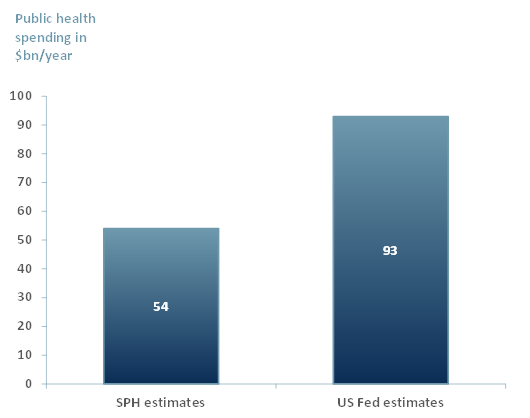Behavioural health coding double-accounted for in US official reports
In a University of Minnesota School of Public Health (SPH) recent publication in the American Journal of Public Health, it was reported that the US federal public health expenditure has been overestimated by at least 2x.
In 2019, the US National Health Expenditure Accounts reported that the government spent USD 93bn on public health out of the USD 3.6trn allocated for total healthcare.
Jonathon P. Leider, a senior lecturer at SPH and the study lead author, declared that the true public health spending number is approximately half of the official number of $96bn i.e. the true value is in the range $36 to $54bn per year, according to Leider’s research and as illustrated in our Exhibit 1 below.
Exhibit 1 – US public health spending – SPH vs. US Fed estimates, 2019

Source: ACF Equity Research; University of Minnesota School of Public Health (SPH)
SPH’s research was based on 2.7m expenditure records from state governments and disclosed that the Fed figures were largely overestimated. SPH’s research assessed if the estimates and the data were accurately captured.
Leider reported that only 39% of records in the official reports reflected true spending figures.
The results determined that expenditures were incorrectly coded and therefore incorrectly categorised in three areas – behavioural health care, disability care, and outpatient care. The research also discovered that these codes are being double counted in the Expenditure Accounts.
These errors not only overestimate the amount of funds allocated for these types of care they also overemphasize the amount of care that might actually be required. This is perilous as funds may be shifted from other areas that may need it most, leaving the most vulnerable at risk.
Leider correctly stressed that much more needed to be done to protect and improve the population’s health, especially in the face of the current Covid-19 health crisis and the economic challenges that have drawn out deep disparities amongst the high-risk.
Determining the exact expenditure on public health by using the correct codes and categorisation will help the understanding of how much funding is needed.
More accurate data will also create a significant advantage when it comes to tackling the different challenges in allocating healthcare spending as outlined above.
More accurate accounts should also help inform plans for a better response to the current and future pandemics.
Accurate information leading to adequate support improves the chances of reducing fiscal and financial liabilities whilst still delivering a better health system in a country that is already suffering from wide inequalities.
This could be interesting and attractive to investors because of two factors that tend to be interrelated:
- On the one hand, the market could be overestimating the healthcare sector’s opportunities in the sub-sectors of behavioural health care, disability care, and outpatient care, leading to over-valuation of stocks in the sub-sectors because investors think the market opportunity is twice as big as it actually is.
- On the other hand, this overestimation, if it leads to an aggressive downward valuation correction, can raise public awareness, leading to political pressure.
Politicians will look for a response and, in such circumstances, that response is likely to manifest itself as more cash and ‘looser’ regulation.
Politicians have a tendency to ‘overreact’ in the heat of political pressure – in this case by injecting additional funds into behavioural health care, disability care, and outpatient care and changing regulations and policies.
The upshot after a period of investor pain is a greater expansion of the market opportunity than is currently visible.
It is timely and appropriate for researchers to hold the public health expenditure accounts under the fire of scrutiny. In reviewing the official Federal healthcare accounts, the researchers hope to accurately identify what the population really needs in terms of public health.
But now, companies and investors should look to readjust their priorities to reflect the genuine data in their reports and valuations where necessary. In other words – cleanse the market of the erroneous numbers in order to draw out the real current and possible future investment opportunities.
















